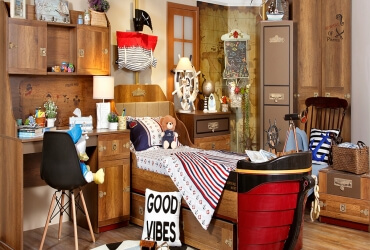Color, Pattern, & Texture

Not unlike adult furniture, consistency of color and pattern is basic to a room’s design success. In designing children’s furniture, “colors should be serene, but mixed with pops of color and pattern. Furniture and textiles should be soft for getting wild!” It is adroitly observed that “color evokes mood and drama, while patterns promote individuality. Using color, pattern, and texture enables the parent and the child to create a unique space that is all their own. Strong colors and graphic patterns are great for high energy, creative types, while delicate patterns and soft palettes are wonderful for the introspective little ones Contrast works well for boys and girls, but can also be a fun choice for twins or siblings sharing space.
There is definitely an art to designing successful children’s furniture. By understanding the psychological and functional needs of children in their surroundings, successful smaller -scaled furniture can be made for both imaginative and multi-functional needs. High Quality Preschool Furniture & Preschool Classroom Design Play a Pivotal Role in Children’s Acquisition of Knowledge Every Early Childhood classroom has a teacher who is seen yet not heard. This teacher touches each and every child in a manner that is so simple yet so complex that the children don’t even know that they are being influenced by her. No matter how many teachers there are in the room, this teacher is always a welcome, appreciated, highly influential, yet silent extra. The teacher to whom I am referring is the walls, space, design, centers & preschool furniture found in an Early Childhood classroom. Each of the aforementioned act as learning tools for the young children in our care and each must be given a great deal of attention when setting up an Early Childhood classroom that values creativity, independent thinking and physical and emotional safety.




